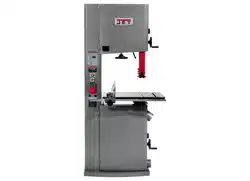Loading ...
Loading ...
Loading ...

21
6. Turn on band saw and allow a few seconds for
the machine to reach full speed.
Whenever possible, use a push
stick, hold-down, power feeder, jig, or similar
device while feeding stock, to prevent your
hands getting too close to the blade.
7. Place the straightest edge of the workpiece
against the fence and push the workpiece
slowly into the blade. Do not force the
workpiece into the blade.
When cutting, do not overfeed
the blade; overfeeding will reduce blade life and
may cause the blade to break.
8. When cutting long stock, the operator should
use roller stands, support tables, or an assistant
to help stabilize the workpiece.
9.2 Ripping
Ripping is cutting lengthwise through the workpiece,
and with the grain (of wood stock). See Figure 9-2.
Figure 9-2
9.3 Crosscutting
Crosscutting is cutting across the grain of the
workpiece, while using the miter gauge to feed the
workpiece into the blade.
Slide the bar of the miter gauge into the end of the
slot on the table.
The right hand should hold the workpiece steady
against the miter gauge, while the left hand pushes
the miter gauge past the blade, as shown in Figure
9-3.
Do not use the fence in conjunction with the miter
gauge. The offcut of the workpiece must not be
constrained during or after the cutting process.
Using the fence in conjunction
with the miter gauge can cause binding and
possible damage to the blade.
Figure 9-3
9.4 Resawing
Resawing is the process of slicing stock to reduce
its thickness, or to produce boards that are thinner
than the original workpiece. Figure 9-4
demonstrates resawing.
The ideal blade for resawing is the widest one the
machine can handle, as the wider the blade the
better it can hold a straight line.
When resawing thin stock, use a push block, push
stick, or similar device to keep your hands away
from the blade.
Figure 9-4
9.5 Blade Lead
Blade lead, or drift, is when the blade begins to
wander off the cutting line even when the band saw
fence is being used. Figure 9-5 shows an example
of blade lead. It is more common with small, narrow
blades, and is almost always attributable to poor
blade quality, or lack of proper adjustments. Inspect
the band saw for the following:
• Fence not parallel to miter slot and blade.
• Blade not tensioned correctly.
• Blade is dull.
• Teeth have excessive “set” on one side of
blade.
• Workpiece being fed too quickly.
Loading ...
Loading ...
Loading ...
